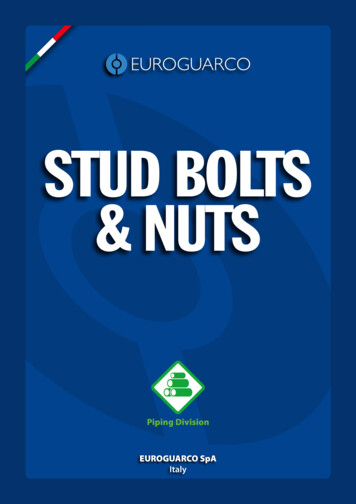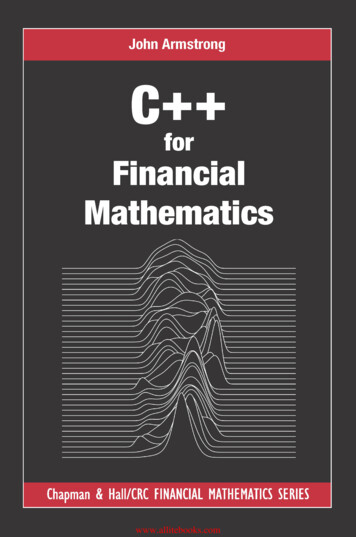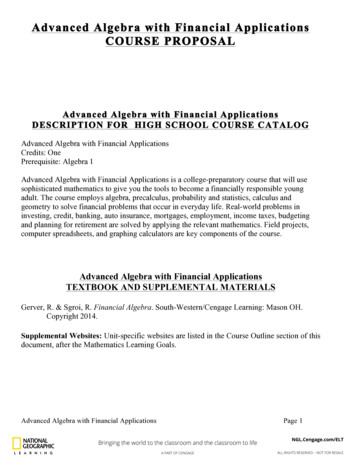
Transcription
Advanced Financial MathematicsLecture Notes Summer Term 2021
Contents1 Informal Introduction1.1 Financial securities . . . .1.1.1 Options . . . . . .1.1.2 long, short . . . . .1.1.3 Zero Coupon Bond1.2 Arbitrage . . . . . . . . .1.2.1 Put-Call Parity . .1.2.2 Chooser-Option . .55669910112 The Black-Scholes Model132.1 Wiener-Process . . . . . . . . . . . . . . . . . . . . . . . . . . . . . . . . 132.2 Pricing in the Black-Scholes Model . . . . . . . . . . . . . . . . . . . . . 193 Preliminaries from Stochastic Analysis3.1 Martingales . . . . . . . . . . . . . . . . . . . . .3.1.1 Optional Sampling . . . . . . . . . . . . .3.1.2 Doob’s martingale inequalities . . . . . . .3.2 Stochastic Integration . . . . . . . . . . . . . . .3.2.1 Motivation . . . . . . . . . . . . . . . . . .3.2.2 The Doléans-measure . . . . . . . . . . . .3.2.3 The Stochastic Integral . . . . . . . . . . .3.2.4 The Integral-process . . . . . . . . . . . .3.3 Quadratic Variation Process . . . . . . . . . . . .3.3.1 Finite Variation . . . . . . . . . . . . . . .3.3.2 The Quadratic Variation . . . . . . . . . .3.3.3 The quadratic covariation . . . . . . . . .3.4 Localisation . . . . . . . . . . . . . . . . . . . . .3.4.1 Local Spaces . . . . . . . . . . . . . . . . .3.4.2 Quadratic Variation for Local Martingales3.4.3 Stochastic Integral for Local Martingales .3.5 Ito Calculus . . . . . . . . . . . . . . . . . . . . .3.5.1 Ito-Formula . . . . . . . . . . . . . . . . .3.5.2 First Applications . . . . . . . . . . . . . .3.5.3 Doléans Exponential . . . . . . . . . . . .3.5.4 Linear Stochastic Differential Equations .3.6 Three Main Theorems . . . . . . . . . . . . . . .3.6.1 Theorem of Lévy . . . . . . . . . . . . . 104
3.6.23.6.3Martingale Representation Theorem . . . . . . . . . . . . . . . . . 107Theorem of Girsanov . . . . . . . . . . . . . . . . . . . . . . . . . 1124 Ito-Process Models of Finance4.1 Basic Concepts . . . . . . . . . . . . . . . . . . . . . . . . . . . . . . . .4.1.1 Motivation . . . . . . . . . . . . . . . . . . . . . . . . . . . . . . .4.1.2 Technical Remarks . . . . . . . . . . . . . . . . . . . . . . . . . .4.1.3 Model Specification . . . . . . . . . . . . . . . . . . . . . . . . . .4.1.4 Trading . . . . . . . . . . . . . . . . . . . . . . . . . . . . . . . .4.2 The Fundamental Theorem of Asset Pricing . . . . . . . . . . . . . . . .4.2.1 No Admissible Arbitrage Opportunities . . . . . . . . . . . . . . .4.2.2 No Free Lunch with Vanishing Risk . . . . . . . . . . . . . . . . .4.3 Pricing of European Derivatives . . . . . . . . . . . . . . . . . . . . . . .4.3.1 Pricing in a Complete Market . . . . . . . . . . . . . . . . . . . .4.3.2 PDE Approach . . . . . . . . . . . . . . . . . . . . . . . . . . . .4.3.3 Examples . . . . . . . . . . . . . . . . . . . . . . . . . . . . . . .4.3.4 PDE Approach for Barrier Options . . . . . . . . . . . . . . . . .4.3.5 Sharpe Ratio . . . . . . . . . . . . . . . . . . . . . . . . . . . . .4.3.6 Construction of a Money Market Account in a Multi-DimensionalComplete Market . . . . . . . . . . . . . . . . . . . . . . . . . . .4.3.7 Pricing in Incomplete Markets . . . . . . . . . . . . . . . . . . . .4.4 Pricing of American Derivatives . . . . . . . . . . . . . . . . . . . . . . .4.4.1 American Claim . . . . . . . . . . . . . . . . . . . . . . . . . . . .4.4.2 Snell-Envelope . . . . . . . . . . . . . . . . . . . . . . . . . . . . .4.4.3 Optimal Stopping . . . . . . . . . . . . . . . . . . . . . . . . . . .4.4.4 Computing . . . . . . . . . . . . . . . . . . . . . . . . . . . . . .4.5 Volatility Models . . . . . . . . . . . . . . . . . . . . . . . . . . . . . . .4.5.1 Calibration of a Black-Scholes Model . . . . . . . . . . . . . . . .4.5.2 Calibration of a Black-Scholes model with deterministic volatility4.5.3 Calibration of a Local Volatility Model . . . . . . . . . . . . . . .4.5.4 Stochastic Volatility Models in General . . . . . . . . . . . . . . .1201201201211231291321321411441441521541571595 Modelling Bond Markets5.1 Basic Concepts . . . . . . . . . . . . . . . . . . . . . . . . .5.1.1 Existence of an Equivalent Local Martingale Measure5.1.2 The Short Rate Approach . . . . . . . . . . . . . . .5.2 Pricing of Derivatives . . . . . . . . . . . . . . . . . . . . . .5.2.1 Forward Martingale Measure . . . . . . . . . . . . . .5.2.2 Pricing of a Call-Option . . . . . . . . . . . . . . . .5.2.3 Pricing of Caplets . . . . . . . . . . . . . . . . . . . .5.2.4 Caplets, Caps, Floorlets und Floors . . . . . . . . . .5.2.5 Swaps . . . . . . . . . . . . . . . . . . . . . . . . . .5.3 Libor Market Model . . . . . . . . . . . . . . . . . . . . . .5.3.1 Model Specification . . . . . . . . . . . . . . . . . . 0172176182184184186186188
5.3.25.3.3Terminal Measure . . . . . . . . . . . . . . . . . . . . . . . . . . . 223Further Libor-Market-Models . . . . . . . . . . . . . . . . . . . . 2284
1 Informal IntroductionThis chapter gives a preliminary introduction to financial markets and its ingredients.1.1 Financial securitiesOn financial markets so called financial securities are traded. These are for example- stocks ( VW, Telekom, Apple, Google, Tesla, etc. )- bonds ( government bonds, corporate bonds, etc. )- foreign currencies ( Dollar, Euro, British Pound, etc.)- commodities ( oil, electricity, noble metals like gold, silver etc. , agriculturalcommodities etc. )Based on these assets further financial contracts can be derived. Examples of thesederivatives are- Options- Swaps, Floating Rate Note (FRN), Swaptions, Caps, Floors- forwards, futuresMarket places where these assets are traded are so called spot markets and futuresmarkets. Examples are- Exchanges ( Stock Exchange, Currency Exchange, Commodities Exchange )- futures exchange ( German Futures Exchange, Chicago Board of Trade, etc. )- derivatives exchange ( German Futures and Derivatives Exchange )The financial securities traded on these market places are- normalised contracts. These are standardised securities that allow an efficient andvery cheap trading.- OTC contracts. These are tailor-made and highly specific.5
1.1.1 OptionsThe so called plain vanilla options are puts and calls. These are simple derivatives onan underlying and can be explained in the following. Ingredients are- the running time T , also called maturity,- the strike K,- an underlying denoted by S,1. The call gives its holder the right to buy the underlying at the initially predetermined strike price K at maturity T .2. The put gives its holder the right to sell the underlying at the initially predetermined strike K at maturity T .If the price S(T ) at maturity of the underlying exceeds K, then the call holder can usehis option to buy the underling at K and sell it immediately at S(T ). He would achievea payoffC(T ) (S(T ) K) .If S(T ) K then the holder of a put can buy the underlying at a price S(T ) and useshis put-option to sell it immediately at a price S(T ). Hence he receives at T a payoffP (T ) (K S(T )) .Mathematically speaking, put and call can be seen as derivatives that achieve a payoffC(T ) (S(T ) K) , resp. , P (T ) (K S(T )) .1.1.2 long, shortA trader initially buys and sells financial assets and builds a portfolio. During tradingtime he changes his positions and balances his portfolio. He takes a- long position in an asset, if he owns the asset.- short position in an asset, if he has sold the asset.For example- A long call position pays the call value at buying time and receives the payoff atmaturity.- A short call position receives the value of the call contract when selling and has todeliver the payoff at maturity.6
- A long stock position pays the stock value at buying time, gets all benefits likedividends during the holding time and receives the changed stock value at sellingtime.- A short stock position receives the stock value at selling time and has to pay thechanged stock value in order to neutralise his position at a future time point.The different effects these positions cause can be visualised by payoff resp. profit diagrams. These are plots at a specific time point, usually maturity, in dependence of theunderlying value. Examples area) long call with strike K and maturity T . Payoff (S(T ) K) Payoff0STKCosts: Initial call price: c 0Profit: (ST K) cProfitK0-cSTb) long put with strike K and maturity T , payoff (K S(T )) 7
Payoff0STKCosts: Initial put price: p 0Profit: (ST K) pProfitK0-pSTc) short call with strike K and maturity TPayoff: (ST K) Profit: c (ST K) Payoff0Profitc08KSTKST
d) short put with strike K and maturity TPayoff: (K ST ) Profit: p (K ST ) Payoff0Profitp0KSTKST1.1.3 Zero Coupon BondA zero coupon bond denotes a financial security that delivers a payoff of 1 money unit(Euro) at maturity T . The holder of a zero coupon bond receives no coupons during therunning time. This contract can be seen as loan. The holder pays initially the bond priceB(0, T ) 1 to the seller and receives at maturity the loan sum 1 Euro. The difference1 B(0, T ) can be seen as coupon resp. interest which is paid at maturity. Zero couponbonds do not have a great volume as traded bonds in bond markets. Its importancerelies in the fact that their prices can be computed from prices of traded bonds. Theyare easier to understand and give easier information on the state of the bond marketresp. its evolution. A zero-coupon bond with maturity T is also called T -bond shortly.Its price-process will be denoted by (B(t, T ))t T . The initial-state of the bond marketcan be expressed by the so called term-structure of bond prices. This is the bond priceas function of maturity (B(0, T ))T 0 . The evolution of the bond-market with time canbe modelled by the change of the term-structure of bond prices with time.1.2 ArbitrageAn arbitrage denotes an opportunity for a trader to achieve a risk-less profit. Forexample, this means that he may receive a positive payoff without any initial capital.9
Thus he is able to get a free lunch which stands as an alternative expression for anarbitrage opportunity. The main assumption is:Financial markets are free of arbitrage.The whole pricing of financial securities rely on this basic assumption and this is justifiedin efficient and transparent markets where no barriers on trading exist. If an arbitrageoccurs, for example due to miss-pricing of a financial security, the efficient price-buildingin markets would cancel this miss-pricing in very short time.Based on this no-arbitrage principle several conclusions can be drawn which are of greatimportance for pricing derivatives.Theorem 1.2.1 (Replication Principle). We consider a financial market with dividendfree assets. If two self-financing trading strategies with value processes V and W coincideat a time point T they coincide at each time point t [0, T ] in between. HenceV (T ) W (T ) V (t) W (t) for all 0 t T.Note that the replication principle is no mathematical theorem, since we have not established a mathematical model so far and cannot state mathematical claims. But wecan give arguments why the replication-principle can be deduced from the no-arbitrageprinciple.Proof. We would like to show that the initial prices V (0) and W (0) of both strategiescoincide and assume first that V (0) W (0).But then we can- initially sell V buy W ,- follow the trade of W and trade opposite to V in (0, T ),- take the payoff W (T ) of W at the end to neutralise the obligation of V (T ) at theend.This strategy would provide an arbitrage opportunity, the risk-less profit V (0) W (0)from the beginning.In the case W (0) V (0) the same arguments work the other way round.1.2.1 Put-Call ParityAs application of the replication principle we will show that there is a correspondencebetween put and call price of an underlying with the same maturity and strike. This isthe so called put-call parity.Theorem 1.2.2 (Put-Call Parity). We consider a put and a call with same strike Kand maturity T on a dividend-free underlying. Let S0 , c, p denote the inital price of theunderling, call and put. Thenp S0 c KB(0, T ).10(1.1)
Proof. To show the assertion we consider two trading strategies.(i) long in put and long in the underlying,(ii) long in call and K long in a T -Bond.Both strategies get a payoff max{S(T ), K} at T due to(K S(T )) S(T ) max{S(T ), K} (S(T ) K) K.The replication principle implies that their initial prices coincide. But this is the claimedequation (1.1) above.The first strategy above underlines the importance of the put-option in risk management.If you buy a stock you face the risk of a downside stock movement. To cover this riskyou can buy in addition a put with strike K. Then your payoff will exceed at least thestrike K. A put can be seen as an insurance contract protecting against downside stockmovements.1.2.2 Chooser-OptionA further application of the replication principle can be given in order to express theprice of a so called chooser-option by a suitable call and put price.We consider a financial market with- deterministic, constant interest rate r 0. This means that the price of a T bondis given by B(t, T ) e r(T t) ,- an underlying S,- puts and calls of all maturities and strikes.A chooser-option gives its holder the right to choose at T1 T a put or a call withstrike K and maturity T . Let ch(T1 , T, K) , c(S0 , T, K), p(S0 , T1 , Ke r(T T1 ) ) denotethe initial price of the chooser-option, the call with maturity T , strike K and the putwith maturity T1 and strike Ke r(T T1 ) . ThenProposition 1.2.3.ch(T1 , T, K) c(S0 , T, K) p(S0 , T1 , Ke r(T T1 ) )Proof. The holder of a chooser-option will take a call in T1 if its more valuable than thecorresponding put. If we denote by c(S(T1 ), T, K) and p(S(T1 ), T, K) their prices in T1 ,then the chooser-option can be seen as a derivative with payoffC (S(T ) K) 1{c(S(T1 ),T,K) p(S(T1 ),T,K)} (K S(T ) 1{p(S(T1 ),T,K) c(S(T1 ),T,K)} .11
The question is how to replicate this payoff. The key observation is that we can reformulate the choose condition by applying the put-call parity. It holdsc(S(T1 ), T, K) Ke r(T T1 ) p(S(T1 ), T, K) S(T1 )and thereforec(S(T1 ), T, K) p(S(T1 ), T, K) S(T1 ) Ke r(T T1 ) .This leads to the replicating strategy:1. At the beginning:- Take a long position in a call with strike K and maturity T- Take a long position in a put with strike Ke r(T T1 ) and maturity T12. at T1 , if S(T1 ) Ke r(T T1 ) :- exercise the put and receive Ke r(T T1 ) S(T1 )- sell the call and receive c(S(T1 ), K, T )- use the received money to buy a put option with strike K and maturity T .3. at T1 , if S(T1 ) Ke r(T T1 ) : hold the call until T .This strategy is self-financing and provides the payoff of the chooser option at T . Thereplication principle implies the above assertion.12
2 The Black-Scholes ModelBlack and Scholes developed in 1971 the approach of pricing derivatives by computingreplicating trading strategies. They were able to derive pricing formulas for plain-vanillaoptions like call and put, in particular the famous Black-Scholes call-price formula. Thebenefits of the model are the following:- simple model- reasonable economic background- analytically tractableThis will be explained in this chapter.2.1 Wiener-ProcessThe Wiener-process, also called Brownian-motion, is one of the most important stochastic processes in continuous time with continuous paths. It is the starting point forthe development of the stochastic integration theory and many sophisticated models inphysics and economics use this process as basic tool. A Wiener-process can be seenas the continuous counterpart of a centered random-Walk and can be constructed aslimiting process of suitable normalised centered random-walks.To be more precise let (Yk )k N be a sequence of identically distributed independentrandom variables with1P(Yk 1) P(Yk 1)2PPutW (1) (t) : tk 1 Yk .By linear interpolation weobtain a continuous time123process with continuous0paths (W (1) (t))t 0 .Enlarge the frequency atfactor n and compress theheight at n Pk1(n) k Define W n j 1 Yj .n13
1n2n3n4n1kn023 Again linear interpolation leads to a continuous time stochastic process W (n) (t) t 0 .This sequence W (n) converges to a limiting process (W (t))t 0 , a Wiener-process.A random-walk is a discrete time stochastic process with independent and stationaryincrements. This property carries over to the limiting process W and can be used togive a precise definition of a Wiener-process.Definition 2.1.1. Let (Ω, F, P) be a probability space and (Ft )t 0 a filtration. Anadapted stochastic-process W (W (t))t 0 is called standard Wiener-process if it fulfills the following properties1. W (0) 0 P-a.s.2. W (t s) W (t) is independent of Ft for all s, t 03. W (t s) W (t) has the same law as W (s) for all s, t 04. W (t) is N(0, t) distributed for all t 05. The paths of W are P-a.s. continuous.Usually we omit the adjective standard and speak of a Wiener-process when a standardWiener-process is meant.Martingales play an essential role in many fields of probability theory, in particular infinance and stochastic analysis.Definition 2.1.2. An adapted process M is called an (Ft )t 0 martingale if the followingholds1. E M (t) for all t 0.2. E(M (t s) Ft ) M (t) for all t, s 0.The independence of the increments can be used to easily identify basic martingaleswhich will play a role in the following.Proposition 2.1.3. Let W be a Wiener-process w.r.t. a filtration (Ft )t 0 . Then thefollowing process are martingales.1. W (t)t 014
2. (W (t)2 t)t 03. (exp(θW (t) 12 θ2 t))t 0 for each θ R.The proof of this assertion is very easy and can be done by carefully exploiting theindependence of increments property. The last martingale is an example of a so calledexponential martingale and can be used to define further probability measures. Thetherefore needed tool is a generalisation of Bayes-Theorem.Theorem 2.1.4 (Change of measure). Let (Ω, F, P) be a probability space with filtration(Ft )t 0 . Let L be a positive martingale w.r.t. P and P̄ a further probability measure on(Ω, F, P) such thatdP̄ F L(t) for all t 0.dP tThen(i) The conditional expectation w.r.t. P̄ can be calculated by computing the conditionalexpectation w.r.t. P. More precisely, if Y is measurable w.r.t. Ft and integrablew.r.t. P̄, then for s tE(Y L(t) Fs )Ē(Y Fs ) .L(s)(ii) M is a P̄-martingale if and only if M L is a P-martingale.(iii) Let R be a positive P-martingale with ER(t) 1 for all t 0. Then a probabilitymeasure QT can be defined on each FT bydQT F R(t) for all t T.dP tProof. (i): We use the definition of conditional expectation directly. For A Fs wegetZZZZE(Y L(t) Fs )E(Y L(t) Fs )dP Y dP̄ Y L(t)dP dP̄.L(s)AAAAThis yields the first assertion.ad (ii): This follows from (i) due to(Mt ) is a P-martingale E(Mt Fs ) Msfor all s t1 E(Mt Lt Fs ) Msfor all s tLs E(Mt Lt Fs ) Ms Lsfor all s t M L is a P-martingale15
ad (iii) Due to ER(T ) 1 an equivalent probability measure on (Ω, FT ) is defined byZR(T )dP for all A FT .QT (A) ADue todQT F E(R(T ) Ft ) R(t)dP tfor all t T the assertion follows.The preceding theorem can be used to state a first simple version of Girsanov’s theoremTheorem 2.1.5 (Girsanov). Let (Ω, F, P) be a probability space with filtration(Ft )t 0and W a Wiener-process w.r.t. P. Let Pϑ be a further probability measure on (Ω, F)such that1dPϑ Ft exp(ϑW (t) θ2 t) L(t) for all t 0.dP2ThenW̄ (t) W (t) ϑt, t 0defines a Wiener-process w.r.t. Pθ .Proof. One has to verify that W̄ satisfies the defining properties of a Wiener-processw.r.t. Pϑ . Clearly W̄ starts at 0 and has continuous paths. To show that the incrementsare independent we consider g : R R measurable and bounded. ThenEϑ (g(W (t) W (s)) Fs ) E(g(W (t) W (s))Lt Fs )1Ls1with Lt exp(ϑW (t) ϑ2 t)2 E(g(W (t) W (s) ϑ(t s))Lt Fs )Ls1 E(g(W (t) W (s) ϑ(t s)) exp(ϑ(W (t) W (s)) ϑ2 (t s)) Fs )21 2 Eg(W (t) W (s) ϑ(t s)) exp(ϑ(W (t) W (s)) ϑ (t s))21 2 Eg(W (t s) ϑ(t s)) exp(ϑW (t s) ϑ (t s))2 Eϑ g(W (t s))Hence, W̄ (t) W̄ (s) is independent of Fs and equally distributed as W̄ (t s) with aN(0, t s)-distribution due to16
1Eϑ g(W (t)) Eg(W (t) ϑt) exp(ϑW (t) ϑ2 t)21 Eg(W (t) ϑt) exp(ϑ(W (t) ϑt) ϑ2 t)2Z1 2 e 2 ϑ t g(x)eϑx N ( ϑt, t)(dx)Z1 211ϑ t2 eg(x)eϑx exp( (x ϑt)2 )dx2tZ2πt1 21 g(x)e 2t x dxZ 2πt g(x)N (0, t)(dx)The Wiener-process W fulfills a further property which is of interest in finance for pricingbarrier options. This is the so called reflection principle.Let τ be a stopping time with P(τ ) 1 . Then the reflected process w.r.t. τ isdefined by(W (t)for t τŴ (t) (2.1)W (τ ) (W (t) W (τ )) for t τThe reflection principle states that Ŵ is also a Wiener-process. This can be proven byexploiting the strong Markov property of the Wiener-process. A useful application isthe computation of the joint distribution of W (T ) and M (T ) supt T W (s).Theorem 2.1.6. Let W denote a Wiener-process and M its running maximum. Thenfor x R and z x it holdsx 2zxP(W (T ) x, M (T ) z) Φ( ) Φ( )TTwith Φ denoting the distribution function of the N(0, 1)-distribution.For the process X defined by X(t) W (t) at it followsx 2z aTx aT ) e2az Φ().P(X(T ) x, sup X(t) z) Φ( t TTTProof. For x R and z x we consider the first time that W reaches z, i.e.τ inf{t 0 : W (t) z}and denote by Ŵ the reflected process w.r.t. τ . Then Ŵ is a Wiener-process andP(W (T ) x, M (T ) z) P(Ŵ (T ) z z x, M (T ) z)17
P(Ŵ (T ) 2z x, sup Ŵ (t) z) P(Ŵ (T ) 2z x)t Tx 2z Φ( )TBut this impliesP(W (T ) x, M (T ) z) P(W (T ) x) P(W (T ) x, M (T ) z)xx 2z Φ( ) Φ( ).TTwhich yields the first formula.To prove the second formula we change the measure by applying Girsanov’s theoremand introducing1dPa Ft exp(aW (t) a2 t) for all t T.dP2Then W has the same distribution w.r.t. Pa as X w.r.t. P. HenceP(X(T ) x, sup X(t) z) Pa (W (T ) x, M (T ) z)t TZ1 exp(aW (T ) a2 T )dP2{W (T ) x,M (T ) z} Eg(W (T ))1{M (T ) z}with g(y) exp(ay 21 a2 T )1( ,x] (y).Due to the first formula the condition distribution function fulfills(1if x zP(W (T ) x M (T ) z) Φ( x ) Φ( x 2z )TTif x z.P(M (T ) z)Taking derivative w.r.t. x yields the conditional densityh(y) 1yy 2z(ϕ( ) ϕ( ))T P(M (T ) z)TTfor all y z. This impliesZ Eg(W (T ))1{M (T ) z} P(M (T ) z)g(y)h(y)dy Z x1yy 2z1 (ϕ( ) ϕ( )) exp(ay a2 T )dy 2TTT x aTx 2z aT Φ( ) e2az Φ(),TTsinceZx 1y1 ϕ( ) exp(ay a2 T )dy2TT18(2.2)
1 E1{W (T ) x} exp(aW (T ) a2 T )2x aT Pa (W (T ) x) Pa (W (T ) aT x aT ) Φ( )Tandx1y 2z1 ϕ( ) exp(ay a2 T )dy2TT 1 E1{W (T ) 2z x} exp(a(W (T ) 2z) a2 T )2 exp(2az)Pa (W (T ) 2z x)x 2z aT exp(2az)Φ()TZ2.2 Pricing in the Black-Scholes ModelThe Black-Scholes model is a continuous time model for a financial market that consistsof- a money market account with price process β(t) ert for all t 0 and- a risky asset with price-process1S(t) S(0)eµt exp(σW (t) σ 2 t).2The process W denotes a Wiener-process and µ, σ, r can be seen as parameters that fixthe distribution.- The number µ R denotes the so called rate of return and affects the expectedevolution of the risky asset, sinceES(t) eµtfor all t 0.- The value σ 0 affects the fluctuation of the risky asset due toVar log(S(t)) Var σW (t) σ 2 tS(0)and is often called volatility.- The interest rate r R represents the evolution of a risk-free money marketaccount.19
To take into account the time-value of money the so called discounted price-process isintroduced byS (t) S(t)1 S(0)e(µ r)t exp(σW (t) σ 2 t) for all t 0.β(t)2We observe that only for µ r the discounted price-process is a martingale. In this casethe risky asset has the same expected return as the money market account and we saythat the market is risk-neutral. The question arises whether starting from µ a change ofthe stand-point, a change of measure, can be done such that the market is risk-neutral.This consideration is incorporated in the term equivalent martingale measure.Definition 2.2.1. We consider a Black-Scholes model along the running-time T . Anequivalent martingale measure P is a probability measure on (Ω, FT ) with the followingproperties1. P and P are equivalent probability measures on (Ω, FT ).2. The discounted price process S (t) S(t)β(t), 0 t T is a martingale w.r.t. P .An application of Girsanov’s theorem provides the existence of an equivalent martingalemeasure.Theorem 2.2.2. In a Black-Scholes model with running-time T 0 an equivalentmartingale measure exists.Proof. We know form 2.1.5 that an equivalent probability measure P can be defined by1dP Ft L(t) exp(ϑW (t) ϑ2 t) for all t T.dP2The parameter ϑ has to be chosen such that the discounted price process becomes amartingale. Since W (t) W (t) ϑt is a Wiener-process w.r.t. P we obtain1S (t) S(0)e(µ r)t exp(σW (t) σ 2 t)21(µ r)t S(0)eexp(σ(W (t) ϑt) σ 2 t)21 2(µ r σϑ)t S(0)eexp(σ(W (t) σ t)2Thus S is a martingale if and only ifµ r σϑ 0 and the theorem is proven.20ϑ µ rσ
The existence of an equivalent martingale measure is an important property of the BlackScholes model. It opens a probabilistic way to pricing derivatives. As we will see laterin the course all financial derivatives with an integrable payoff C at T can be replicatedand the initial value of each replicating strategy coincides with the expected discountedpayoff under the equivalent martingale measure. Therefore the following definition isjustified.Definition 2.2.3. Let P be the equivalent martingale measure in the Black-ScholesC . Then the initialmodel and C be an FT -measurable payoff at T with E β(T)arbitrage-free price of C is defined byp0 (C) E C E C .β(T )Later we will clarify why this definition is reasonable. Simply speaking, pricing of aderivative with payoff C at T means- determine a reasonable equivalent martingale measure P - compute E C This pricing mechanism is reasonable in more or less all financial market models andmainly used in practise.Before we give some applications we note that S is a positive martingale under P . Thusa further equivalent change of measure can be done by defining a probability measureP σ viadP σS (t)1 exp(σW (t) σ 2 (t))Ft dPS(0)2for all t T . Girsanov provides thatW (t) W (t) σtis a Wiener-process w.r.t. P σ .To give a full picture we have the following evolution of the stock price process underthe different measure- The subjective probability measure P:1S(t) S(0)eµt exp(σW (t) σ 2 t)2- The equivalent martingale measure P :1S(t) S(0)ert exp(σW (t) σ 2 t)2- The further transformed measure P σ :S(t) S(0)e(r σ2 )t211exp(σW (t) σ 2 t)2
This means that S is a geometric Wiener-process with- trend µ and volatility σ w.r.t P,- trend r and volatility σ w.r.t. P ,- trend r σ 2 and volatility σ w.r.t. P σ .This can be exploited by deriving the Black-Scholes formula.Theorem 2.2.4. We consider a call with maturity T and strike K in a Black-Scholesmodel with volatility σ and initial stock price S(0). Then the initial arbitrage-free priceof the call is given byc(S(0), T, σ, K) S(0)Φ(h1 (S(0), T ) Ke rT Φ(h2 (S(0), T )(2.3)with S(0)K (r 21 σ 2 )T h1 (S0 , T ) σ Tlog S(0) (r 21 σ 2 )TK h2 (S0 , T ) .σ TlogProof. In the first step we computeE e rT (S(T ) K) E? e rT ST 1{ST K} E? e rT K 1{St K}S? S(0)E? T 1{ST K} e rT KE? 1{ST K}S(0)? S(0) Pσ (ST K) e rT K P? (ST K) {z} {z}(1)(2)To compute the probabilities we remind you on the representation of S under P andP σ . It follows KST? logPσ (ST K) Pσ logS(0)S(0) 1K?22 Pσ σWT σ T (r σ )T logS2S(0) K W ?log S(0) 12 σ 2 T (r σ 2 )T T? Pσ T σT {z } N (0,1) 1 2log S(0) (r σ)TK2 . Φ σ T22
and STKP (ST K) P log logS(0)S(0) 1K?2 P σWT σ T rT log2S(0) K W? 12 σ 2 T rT logS(0) T? P T σT {z}? N (0,1) Φ log S(0)K (r 21 σ 2 )T . σ THence (2.3) follows.Note that due to the put-call parity the price of a put can be easily calculated too. Putand call are examples of so called path independent options since the payoff at maturityis only a function of the terminal stock-price. More delicate is the problem of findingpricing formulas for path dependent options. This can be done for so called one-sidedbarrier options.Theorem 2.2.5. A down and out call with maturity T , strike K and barrier B S(0)is an option with payoff (S(T ) K) at maturity T if the barrier B is not hit duringthe running-time. This corresponds to a derivative with payoffC (S(T ) K) 1{inf t T S(t) B} .The initial price of a down and out call is given byp0 (C) c(S0 , T, K) (S0 2bS2) σ c(S0 , T, K 02 )BB(2.4)with b σr 21 σ .This means that the price of a down and out call can be expressed by call prices w.r.t.different strikes.Proof. Nearly the same calculations as in the ordinary call can b
Financial markets are free of arbitrage. The whole pricing of nancial securities rely on this basic assumption and this is justi ed in e cient and transparent markets where no barriers on trading exist. If an arbitrage occurs, for example due to miss-pricing of a nancial security, the e cient price-building










